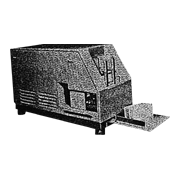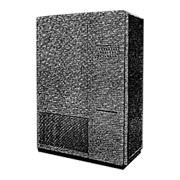This was the first photoelectric card reader from Fuji Tsushinki Manufacturing Corporation (currently Fujitsu). Computers had progressed from relays to transistors, and there was a dramatic improvement in calculation speed. As a result, there was an increasing need for higher speed in input/output devices. Previously, punched card readers read punched positions by opening and closing contacts with a pin or brush, but this system was mechanical and thus was slow and prone to reading errors due to bad connection at contacts. Around 1959, Fuji Tsushinki Manufacturing used photoelectric elements to develop the R-301A photoelectric card reader and thereby enable accurate high-speed reading of data from IBM cards. This unit had the following features:
- Cards were fed in the horizontal direction to improve reading speed, thus resulting in high-speed reading of 300 cards per minute. (This unit was even shown to be capable of reading 500 cards per minute.)
- It was comprised of two parts: a desktop reading mechanism, and a standalone controller.
- Read instructions from the computer. CPU caused card data to be stored in a buffer register (capacity: 60 digits). Upon a transfer instruction, data in the buffer register was converted to code, and transferred to the CPU per one column.
- To keep data within 60 columns, the user could use a plug board to convert 80-column data, or select the necessary part of the 80 columns.
- Ferrite cores were used for the buffer register, and the register was driven and controlled by vacuum tubes.
- The unit had a card hopper capacity of 700 cards, and read cards from the bottom. When the stacker became full with cards, card feed was automatically stopped to prevent damage to cards.
It is not clear what models this card reader was connected with. It was probably connected with the FACOM 212A parametron-based business computer via a FACOM 933 controller.



